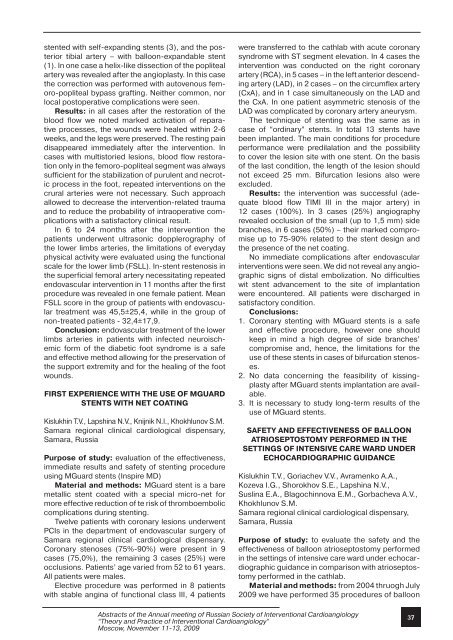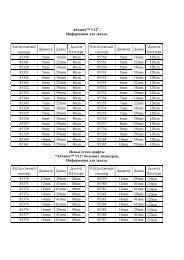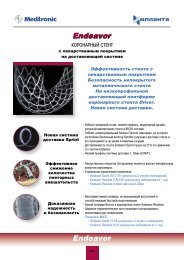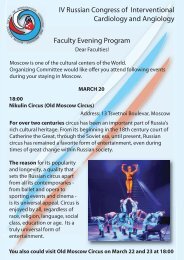Cardiology_english_19_view (1).pdf
Cardiology_english_19_view (1).pdf
Cardiology_english_19_view (1).pdf
- No tags were found...
Create successful ePaper yourself
Turn your PDF publications into a flip-book with our unique Google optimized e-Paper software.
stented with self-expanding stents (3), and the posterior tibial artery – with balloon-expandable stent(1). In one case a helix-like dissection of the poplitealartery was revealed after the angioplasty. In this casethe correction was performed with autovenous femoro-popliteal bypass grafting. Neither common, norlocal postoperative complications were seen.Results: in all cases after the restoration of theblood flow we noted marked activation of reparative processes, the wounds were healed within 2-6weeks, and the legs were preserved. The resting paindisappeared immediately after the intervention. Incases with multistoried lesions, blood flow restoration only in the femoro-popliteal segment was alwayssufficient for the stabilization of purulent and necrotic process in the foot, repeated interventions on thecrural arteries were not necessary. Such approachallowed to decrease the intervention-related traumaand to reduce the probability of intraoperative complications with a satisfactory clinical result.In 6 to 24 months after the intervention thepatients underwent ultrasonic dopplerography ofthe lower limbs arteries, the limitations of everydayphysical activity were evaluated using the functionalscale for the lower limb (FSLL). In-stent restenosis inthe superficial femoral artery necessitating repeatedendovascular intervention in 11 months after the firstprocedure was revealed in one female patient. MeanFSLL score in the group of patients with endovascular treatment was 45,5±25,4, while in the group ofnon-treated patients - 32,4±17,9.Conclusion: endovascular treatment of the lowerlimbs arteries in patients with infected neuroischemic form of the diabetic foot syndrome is a safeand effective method allowing for the preservation ofthe support extremity and for the healing of the footwounds.FIRST EXPERIENCE WITH THE USE OF MGUARDSTENTS WITH NET COATINGKislukhin T.V., Lapshina N.V., Knijnik N.I., Khokhlunov S.M.Samara regional clinical cardiological dispensary,Samara, RussiaPurpose of study: evaluation of the effectiveness,immediate results and safety of stenting procedureusing MGuard stents (Inspire MD)Material and methods: MGuard stent is a baremetallic stent coated with a special micro-net formore effective reduction of te risk of thromboemboliccomplications during stenting.Twelve patients with coronary lesions underwentPCIs in the department of endovascular surgery ofSamara regional clinical cardiological dispensary.Coronary stenoses (75%-90%) were present in 9cases (75,0%), the remaining 3 cases (25%) wereocclusions. Patients’ age varied from 52 to 61 years.All patients were males.Elective procedure was performed in 8 patientswith stable angina of functional class III, 4 patientswere transferred to the cathlab with acute coronarysyndrome with ST segment elevation. In 4 cases theintervention was conducted on the right coronaryartery (RCA), in 5 cases – in the left anterior descending artery (LAD), in 2 cases – on the circumflex artery(CxA), and in 1 case simultaneously on the LAD andthe CxA. In one patient asymmetric stenosis of theLAD was complicated by coronary artery aneurysm.The technique of stenting was the same as incase of “ordinary” stents. In total 13 stents havebeen implanted. The main conditions for procedureperformance were predilalation and the possibilityto cover the lesion site with one stent. On the basisof the last condition, the length of the lesion shouldnot exceed 25 mm. Bifurcation lesions also wereexcluded.Results: the intervention was successful (adequate blood flow TIMI III in the major artery) in12 cases (100%). In 3 cases (25%) angiographyrevealed occlusion of the small (up to 1,5 mm) sidebranches, in 6 cases (50%) – their marked compromise up to 75-90% related to the stent design andthe presence of the net coating.No immediate complications after endovascularinterventions were seen. We did not reveal any angiographic signs of distal embolization. No difficultieswit stent advancement to the site of implantationwere encountered. All patients were discharged insatisfactory condition.Conclusions:1. Coronary stenting with MGuard stents is a safeand effective procedure, however one shouldkeep in mind a high degree of side branches’compromise and, hence, the limitations for theuse of these stents in cases of bifurcation stenoses.2. No data concerning the feasibility of kissingplastyafter MGuard stents implantation are available.3. It is necessary to study long-term results of theuse of MGuard stents.SAFETY AND EFFECTIVENESS OF BALLOONATRIOSEPTOSTOMY PERFORMED IN THESETTINGS OF INTENSIVE CARE WARD UNDERECHOCARDIOGRAPHIC GUIDANCEKislukhin T.V., Goriachev V.V., Avramenko A.A.,Kozeva I.G., Shorokhov S.E., Lapshina N.V.,Suslina E.A., Blagochinnova E.M., Gorbacheva A.V.,Khokhlunov S.M.Samara regional clinical cardiological dispensary,Samara, RussiaPurpose of study: to evaluate the safety and theeffectiveness of balloon atrioseptostomy performedin the settings of intensive care ward under echocardiographic guidance in comparison with atrioseptostomy performed in the cathlab.Material and methods: from 2004 thruogh July2009 we have performed 35 procedures of balloonAbstracts of the Annual meeting of Russian Society of Interventional Cardioangiology“Theory and Practice of Interventional Cardioangiology”Moscow, November 11-13, 200937
















